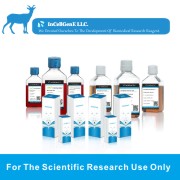

Overview
| Organism | Homo sapiens, human |
|---|---|
| Tissue | prostate/stroma |
| Cell Type | Epithelial, fibroblast, Myofibroblast |
| Product Format | frozen |
| Morphology | myofibroblast |
| Culture Properties | adherent |
| Biosafety Level |
2 [Cells contain SV40 viral DNA sequence]
Biosafety classification is based on U.S. Public Health Service Guidelines, it is the responsibility of the customer to ensure that their facilities comply with biosafety regulations for their own country. |
| Disease | normal |
| Age | 54 years |
| Gender | male |
| Ethnicity | Caucasian |
| Applications | Because of their derivation from the same peripheral zone of the prostate, the WPMY-1 cell line is especially useful for studies on paracrine and stromal : epithelial interactions. |
| Storage Conditions | liquid nitrogen vapor phase |
Properties
| Karyotype | At passage 66, a majority of the cells were in the 58-68 range; X, -Y. Ref |
|---|---|
| Derivation |
The myofibroblast stromal cell line, WPMY-1, was derived from stromal cells from the same peripheral zone of the histologically normal adult prostate, as that used for RWPE-1 cells (ATCC CRL-11609).
Stromal cells were immortalized with SV40-large-T antigen gene, using a pRSTV plasmid construct. WPMY-1 stromal cells belong to a family of cell lines derived from the same prostate as the epithelial RWPE-1 cells and all of its epithelial derivatives. |
| Clinical Data |
54 years
Caucasian, White
male
|
| Antigen Expression |
kallikrein 3, KLK3 (prostate specific antigen, PSA); Homo sapiens
|
| Receptor Expression |
androgen receptor, expressed
|
| Genes Expressed |
fibronectin
smooth muscle alpha-actin
vimentin
|
| Cellular Products |
fibronectin
smooth muscle alpha-actin
vimentin
|
| Tumorigenic | No |
| Effects |
No, into nude mice
(at Passage 22 cells did not form tumors when injected subcutaneously)(Mukta M Webber, personal communication)
Yes, the cells form colonies in soft agar
(colony forming efficiency (CFE) of 0.7%)(Mukta M Webber, personal communication)
|
| Comments |
The depositor reports that the RWPE-1 cell line (ATCC CRL-11609), derived from the same prostate, was screened for Hepatitis B and C, and human immunodeficiency viruses, and was found to be negative.
|
Background
| Complete Growth Medium |
The base medium for this cell line is ATCC-formulated Dulbecco''s Modified Eagle''s Medium, Catalog No. 30-2002. To make the complete growth medium, add the following components to the base medium: fetal bovine serum to a final concentration of 5%. |
|---|---|
| Subculturing |
Volumes used in this protocol are for 75 cm2 flask; proportionally reduce or increase amount of dissociation medium for culture vessels of other sizes.
Note: Subculture cells before or upon reaching confluence. Do not allow cells to become super-confluent.
Subcultivation Ratio: A subcultivation ratio of 1:3 to 1:6 is recommended
Medium Renewal: Every 48 hours
|
| Cryopreservation |
Freeze medium: Complete growth medium supplemented with an additional 15% fetal bovine serum and 10% (v/v) DMSO
Storage temperature: liquid nitrogen vapor phase
|
| Culture Conditions |
Atmosphere: air, 95%; carbon dioxide (CO2), 5%
Temperature: 37��C
Growth Conditions: Subculture cells before or upon reaching confluence. Do not allow cells to become super-confluent.
|


